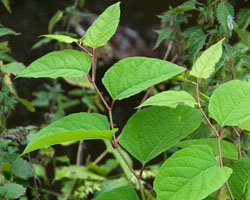
Japanese knotweed is an invasive species of plant which spreads rapidly and overwhelms other plants. It is the fastest growing in the UK.
It can grow almost anywhere and causes serious problems, including loss of native plant species, structural damage (it can grow through asphalt and some other surfaces), reduction in land values and difficulty in obtaining mortgages.
Why is it a problem?
As Japanese knotweed is not native to Europe, the pests and diseases that control it in Japan are not present in the UK.
How do I identify it?
- Green shovel shaped leaves
- Stem is bamboo-like in appearance
- Produces white flowers around September or October.
What you should know
- It is the landowner's responsibility to control these plants. You must not allow it to spread to other people's land or property. However, you do not have to remove it from your own land
- If you see Japanese knotweed on private land e.g. a neighbouring property, a construction site, agricultural fields, speak to the land owner in the first instance. To find out who owns a piece of land, visit HM Land Registry (external link)
- You must not remove or dispose of Japanese knotweed as it could cause the plant to spread, which is an offence
- You must not dispose of Japanese knotweed in your green bin (garden waste) or take it to the tip (household recycling centre) as this is an offence – it must be disposed of as controlled waste.
If you find Japanese knotweed on your own land you can visit GOV.UK (external link) for further information on how to prevent it from spreading.
Japanese knotweed on council land
If you have found Japanese knotweed on council land, you can report it to Wigan Council.
We make every effort to contain the spread of Japanese knotweed on council land and ensure the area is safe as a matter of priority, once reported.